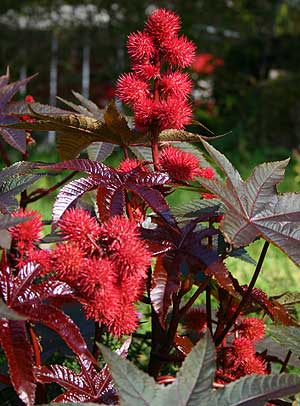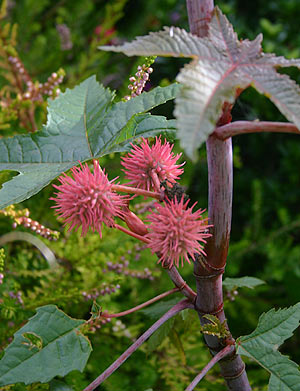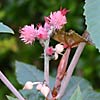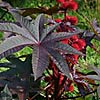Ricinus communus
CASTOR BEAN, CASTOR-OIL PLANT
Family: Apiaceae
Pronounced: RY-sin-us com-MEW-nis
Quick Jumps
Growing Guide
Rainy Side Notes
GROWING GUIDE

Click on thumbnails at the bottom of the page to see individual cultivars of castor bean plants and their attributes.
Origin:
Garden.
Plant Group:
Tender shrub treated as an annual where not hardy.
Mature size:
See cultivar listings.
Hardiness:
Sunset zones: 23, 24, H1, H2.
USDA zones: 11-14.
Heat zones: 12-1.
Treat as an annual outside its hardiness range.
Flowering attributes:
See cultivar listings.
Leaf attributes:
See cultivar listings.
Light:
Full sun for best leaf color.
Soil:
Fertile, humus rich, well-drained, soil.
Feeding:
Add a complete organic fertilizer at planting time and monthly after that.
Propagation Methods:
Soak seed for 24 hours before sowing in 3-inch pots at 70°F (21°C). Plant out when all danger of frost is over.
Pests and Diseases:
Seedling blight may be a problem; use good air circulation around pots when seed germinates. Spider mites may be a problem along with gray mold, charcoal rot, bacterial wilt and bacterial leaf spot.
Rainy Side Notes

Ricinus communis bold foliage lends a tropical appearance to the garden. Indeed, it is a tropical shrub, which we treat as an annual in our maritime climate. From a small seed that resembles a tick, it quickly grows into an imposing plant in the landscape. In fact, its Latin name Ricinus means tick. The genus has only one species—communis, which means common. Throughout the middle ages the plants were called palma Christi (hand of Christ), as the leaf looks like a hand.
The handsome species and cultivars adds bold foliage and brightly colored alien-looking seed pods to the garden. These plants can reach 8 to 10 feet in the garden, but in mine have yet to reach over 4 feet tall.
Caution is advised if you decide to grow any castor bean plant. All parts are highly poisonous. If you have small children, or even pets, it is a wise choice not to grow it. Some people have allergic reactions after handling the plants or seeds.
Click on thumbnails below to view each cultivar of Ricinus with attributes listed for each one.


Debbie Teashon
Photographed in author's garden.

Gardening for the Homebrewer: Grow and Process Plants for Making Beer, Wine, Gruit, Cider, Perry, and More
By co-authors Debbie Teashon (Rainy Side Gardeners) and Wendy Tweton
Copyright Notice | Home | Search | Annuals

